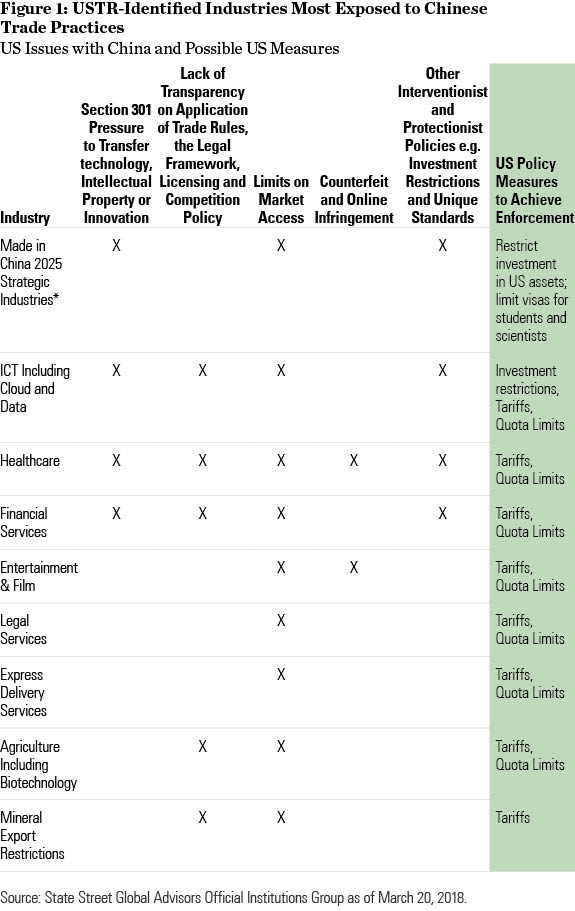Elliot Hentov, head of policy & research at State Street Global Advisors, comments on the current US-China dispute and the impact this could have on the global economy.
By imposing tariffs on aluminium and steel imports, the United States fired its opening salvo in the battle to rebalance trade relations with China.
Now it has launched an investigation into what it considers to be unfair trade practices by China, under section 301 of the US Trade Act, marking a new phase of the trade dispute between the two nations.
We believe that Trump’s actions could have significant and lasting implications for companies in China, certain sectors in the US and global investor portfolios.
For the Trump Administration, the main goal of trade negotiations with China is a reduction in the bilateral trade deficit of US$100 billion (€80 billion).
This gives both parties plenty of negotiating room to arrive at such an outcome without descending into a trade war.
However, the actions, which could take various forms, are likely to be announced before the negotiations begin.
The most likely enforcement actions under section 301 would be denying access to investment in US assets and targeted tariffs being applied to industries where China has a comparative advantage such as electronics, machinery, toys and lighting, and where supply chains could be re-routed.
If these are successful, Chinese industry could be hit hard.
Figure 1 outlines the industries that could be affected by Section 301, as well as the other industries highlighted in the report which US Trade Representative (USTR) says are affected by market-distorting practices. USTR adds that China’s disregard for World Trade Organisation (WTO) rules means the US may decide not to automatically resort to the WTO dispute settlement mechanism to resolve the situation.

In response, China could pursue the “shopping list” approach and commit to Chinese purchases of US goods, helping to boost US exports. It could permit greater foreign competition in certain sectors, i.e., introduce liberalising market reforms.
Such reforms are underway regardless of US trade talks, so China could skilfully present them as a concession to the US, particularly if they occur in sectors with strong US companies.
However, USTR would need to be persuaded that this constituted real change: some US officials view the shopping list approach as allowing China to escape adopting better practices.
Similarly, the authorities in Beijing could comfortably choose to escalate the dispute, resorting to a range of retaliatory measures, including the imposition of counter tariffs (presumably on the most economically and politically concentrated US imports such as soybeans or aircraft).
It could delay scheduled Chinese purchases of US goods and services, penalise US businesses active in China, grant preferential treatment to non-US competitors or restrict Chinese travel to the US (i.e. equal to a tariff on US service exports).
China may also attempt to retaliate through financial markets. It could reduce its significant holdings in US treasuries or delink further from the US dollar.
However, both these actions are unlikely, given that they have multilateral ripple effects and bear risks for the Chinese economy. Foreign exchange and bond markets should therefore remain quiescent.
Higher tariffs will, however, affect equity markets. US retailers that rely heavily on imports from China will be impacted the most, but the full ramifications of these measures will only be known once they come into force.
For example, higher television prices could perhaps mean Chinese-made televisions are substituted for Taiwanese sets. On the other hand, if a Sony TV is partly made in China and partly made elsewhere, it may be that the tariff would apply only to the value-add in China.
The impact on supply-chain linkages is therefore the most difficult to estimate and there could be unintended collateral damage to other countries and companies.
Overall, the negative impact on China’s real GDP growth is estimated by most economists as limited to between 0.2% and 0.4% of GDP, depending on the scale and targeting of the tariffs. However, there could be second-round effects and, for the Chinese, a politically difficult impact on employment.
Moreover, this dispute is not going away. The US has designated China as a strategic rival and shown that it is prepared to act unilaterally, irrespective of WTO conventions. And it is not the only country with concerns about China’s IP practices or the way it has treated overseas companies and investors over the last 30 years.
If the European Union and Japan were to initiate similar proceedings to those engendered by section 301, possibly even through the WTO, China would be hard pressed not to change its behaviour under threat of restricted access to its major markets.
In the meantime, global investors will need to keep a close eye on how this upheaval is affecting companies’ share prices and which sectors may be more or less in the firing line from both sides.
©2018 funds europe





